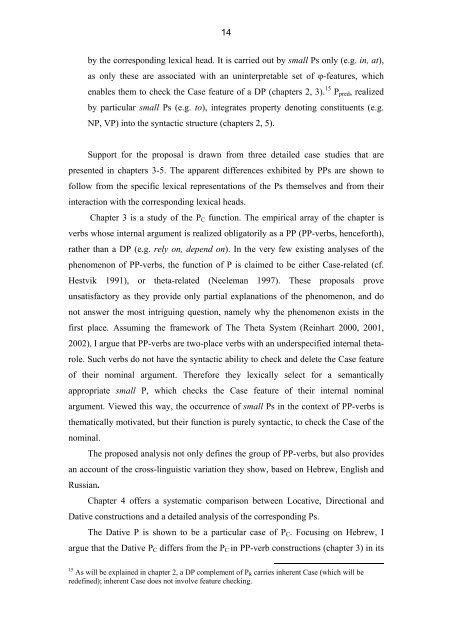The Category P Features, Projections, Interpretation
The Category P Features, Projections, Interpretation
The Category P Features, Projections, Interpretation
Create successful ePaper yourself
Turn your PDF publications into a flip-book with our unique Google optimized e-Paper software.
14<br />
by the corresponding lexical head. It is carried out by small Ps only (e.g. in, at),<br />
as only these are associated with an uninterpretable set of φ-features, which<br />
enables them to check the Case feature of a DP (chapters 2, 3). 15 P pred , realized<br />
by particular small Ps (e.g. to), integrates property denoting constituents (e.g.<br />
NP, VP) into the syntactic structure (chapters 2, 5).<br />
Support for the proposal is drawn from three detailed case studies that are<br />
presented in chapters 3-5. <strong>The</strong> apparent differences exhibited by PPs are shown to<br />
follow from the specific lexical representations of the Ps themselves and from their<br />
interaction with the corresponding lexical heads.<br />
Chapter 3 is a study of the P C function. <strong>The</strong> empirical array of the chapter is<br />
verbs whose internal argument is realized obligatorily as a PP (PP-verbs, henceforth),<br />
rather than a DP (e.g. rely on, depend on). In the very few existing analyses of the<br />
phenomenon of PP-verbs, the function of P is claimed to be either Case-related (cf.<br />
Hestvik 1991), or theta-related (Neeleman 1997). <strong>The</strong>se proposals prove<br />
unsatisfactory as they provide only partial explanations of the phenomenon, and do<br />
not answer the most intriguing question, namely why the phenomenon exists in the<br />
first place. Assuming the framework of <strong>The</strong> <strong>The</strong>ta System (Reinhart 2000, 2001,<br />
2002), I argue that PP-verbs are two-place verbs with an underspecified internal thetarole.<br />
Such verbs do not have the syntactic ability to check and delete the Case feature<br />
of their nominal argument. <strong>The</strong>refore they lexically select for a semantically<br />
appropriate small P, which checks the Case feature of their internal nominal<br />
argument. Viewed this way, the occurrence of small Ps in the context of PP-verbs is<br />
thematically motivated, but their function is purely syntactic, to check the Case of the<br />
nominal.<br />
<strong>The</strong> proposed analysis not only defines the group of PP-verbs, but also provides<br />
an account of the cross-linguistic variation they show, based on Hebrew, English and<br />
Russian.<br />
Chapter 4 offers a systematic comparison between Locative, Directional and<br />
Dative constructions and a detailed analysis of the corresponding Ps.<br />
<strong>The</strong> Dative P is shown to be a particular case of P C . Focusing on Hebrew, I<br />
argue that the Dative P C differs from the P C in PP-verb constructions (chapter 3) in its<br />
15 As will be explained in chapter 2, a DP complement of P R carries inherent Case (which will be<br />
redefined); inherent Case does not involve feature checking.
















